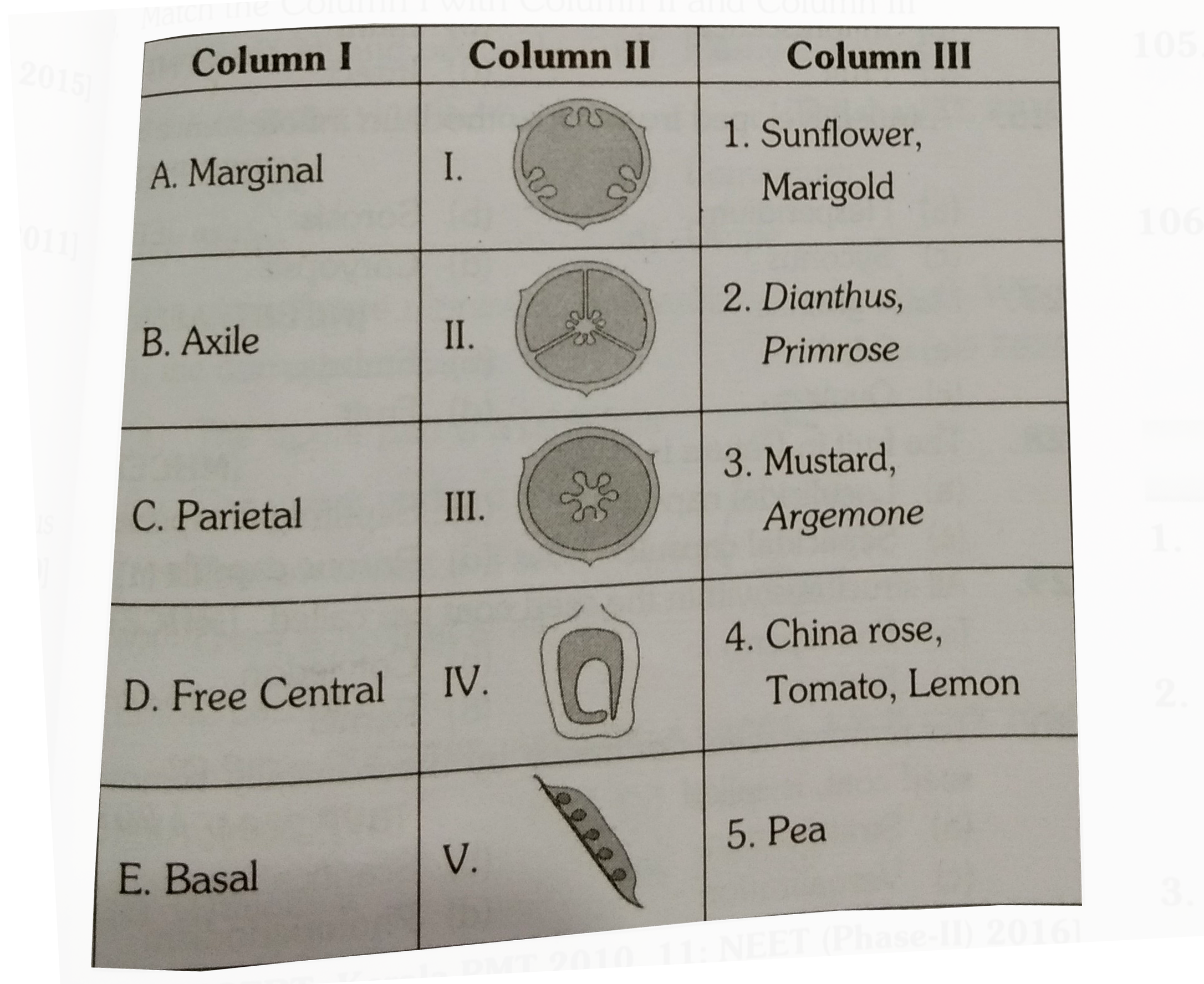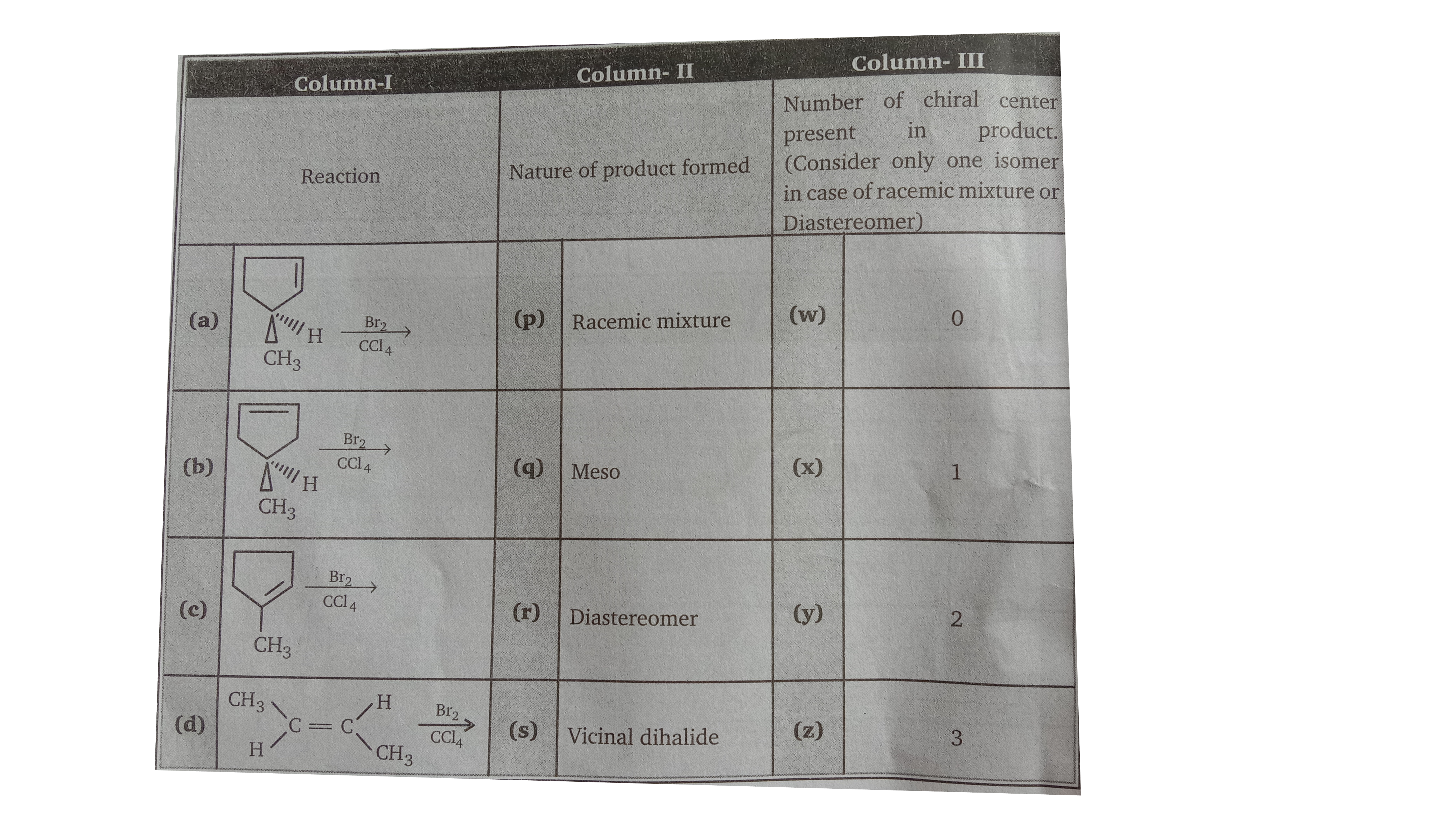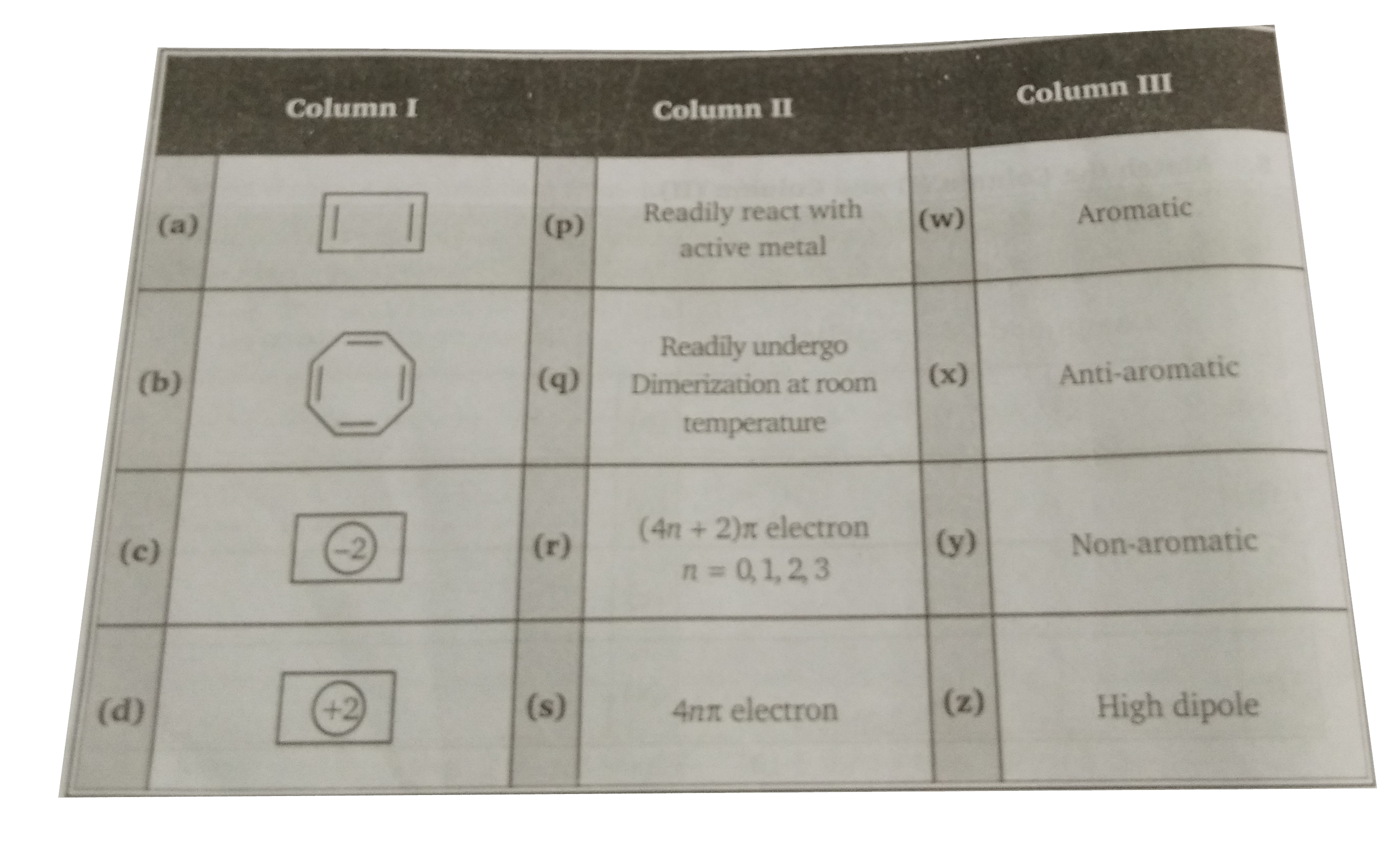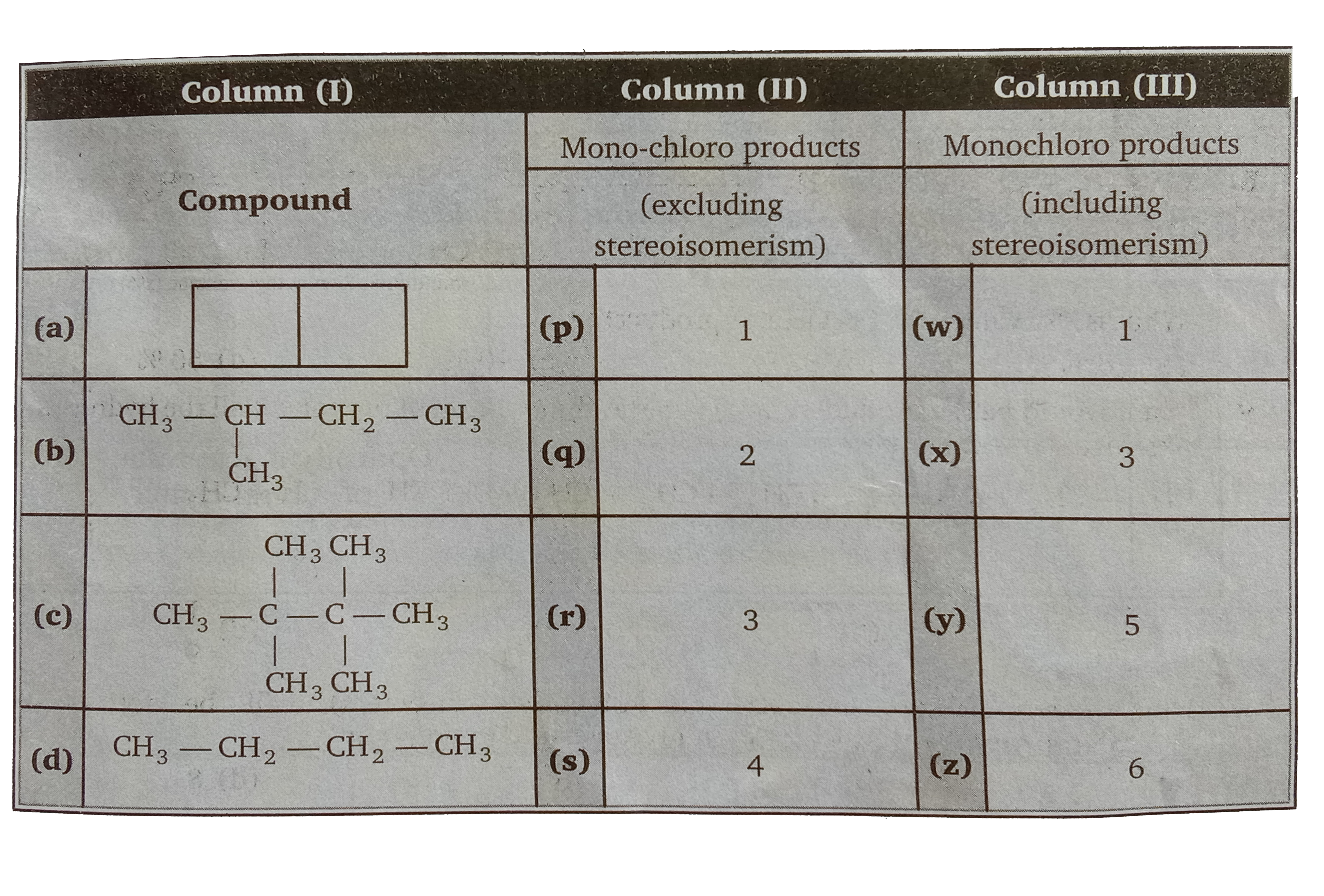Match Column I with Column II.
Column I Column II(i)Equilibrium(a)ΔG>0,K<1(ii)Spontaneous reaction(b)ΔG=0(iii)Non-spontaneous reaction(c)ΔGΘ=0(d)ΔG<0,K>1
The correct Answer is:(i)-(b), (ii)-(d), (iii)-(a)
To solve the problem of matching Column I with Column II, we will analyze each item in Column I and determine its corresponding item in Column II based on the principles of thermodynamics and equilibrium.
1. Identify the first item in Column I: Equilibrium
- At equilibrium, the Gibbs free energy change (ΔG) is equal to zero. This is because the forward and reverse reactions occur at the same rate, resulting in no net change in the system.
- Therefore, the correct match for equilibrium is (b) ΔG = 0.
2. Identify the second item in Column I: Spontaneous reaction
- A spontaneous reaction is characterized by a negative Gibbs free energy change (ΔG < 0). This indicates that the reaction can proceed without external energy input.
- Additionally, for spontaneous reactions, the equilibrium constant (K) is greater than 1, indicating that products are favored at equilibrium.
- Thus, the correct match for spontaneous reaction is (d) ΔG < 0, K > 1.
3. Identify the third item in Column I: Non-spontaneous reaction
- A non-spontaneous reaction occurs when the Gibbs free energy change is positive (ΔG > 0). This means that the reaction requires energy input to proceed.
- For non-spontaneous reactions, the equilibrium constant (K) is less than 1, indicating that reactants are favored at equilibrium.
- Therefore, the correct match for non-spontaneous reaction is (a) ΔG > 0, K < 1.
Final Matches:
- (i) Equilibrium → (b) ΔG = 0
- (ii) Spontaneous reaction → (d) ΔG < 0, K > 1
- (iii) Non-spontaneous reaction → (a) ΔG > 0, K < 1
Summary of Matches:
- i → b
- ii → d
- iii → a
---
- At equilibrium, the Gibbs free energy change (ΔG) is equal to zero. This is because the forward and reverse reactions occur at the same rate, resulting in no net change in the system.
- Therefore, the correct match for equilibrium is (b) ΔG = 0.
- A spontaneous reaction is characterized by a negative Gibbs free energy change (ΔG < 0). This indicates that the reaction can proceed without external energy input.
- Additionally, for spontaneous reactions, the equilibrium constant (K) is greater than 1, indicating that products are favored at equilibrium.
- Thus, the correct match for spontaneous reaction is (d) ΔG < 0, K > 1.
- A non-spontaneous reaction occurs when the Gibbs free energy change is positive (ΔG > 0). This means that the reaction requires energy input to proceed.
- For non-spontaneous reactions, the equilibrium constant (K) is less than 1, indicating that reactants are favored at equilibrium.
- Therefore, the correct match for non-spontaneous reaction is (a) ΔG > 0, K < 1.
- (i) Equilibrium → (b) ΔG = 0
- (ii) Spontaneous reaction → (d) ΔG < 0, K > 1
- (iii) Non-spontaneous reaction → (a) ΔG > 0, K < 1
- i → b
- ii → d
- iii → a
Topper's Solved these Questions
- EQUILIBRIUMBook:PRADEEPChapter:EQUILIBRIUMExercise:NCERT Exemplar Problems with answers, Hints and Solutions (Assertion and Reason Type Questions )
Explore 7 Videos
- EQUILIBRIUMBook:PRADEEPChapter:EQUILIBRIUMExercise:NCERT Exemplar Problems with answers, Hints and Solutions (Long Answer Questions)
Explore 4 Videos
- EQUILIBRIUMBook:PRADEEPChapter:EQUILIBRIUMExercise:NCERT Exemplar Problems with answers, Hints and Solutions (Short Answer Questions)
Explore 16 Videos
- ENVIRONMENTAL CHEMISTRYBook:PRADEEPChapter:ENVIRONMENTAL CHEMISTRYExercise:COMPETITION FOCUS (JEE(Main and Advanced)/Medical Entrance (VI.ASSERTION-REASON) Type II
Explore 6 Videos
- EQUILIBRIUM IN PHYSICAL AND CHEMICAL PROCESSESBook:PRADEEPChapter:EQUILIBRIUM IN PHYSICAL AND CHEMICAL PROCESSESExercise:Competition Focus (Jee(Main and advanced)/Medical Entrance) VIII. ASSERTION - REASON TYPE QUESTIONS (TYPE - II)
Explore 10 Videos
Similar Questions
Knowledge Check
Match the column I with Column II and Column III ltbvrgt
 AA−V,1lB−II,2,C−II,4,D−I,5,E−IV,3BA−V,1,B−II,4,C−I,2,D−III,3,E−IV,5CA−I,5,B−II,4,C−III,3,D−IV,2,W−V,1DA−V,5,B−II,4,C−I,3,D−III,2,E−IV,1
AA−V,1lB−II,2,C−II,4,D−I,5,E−IV,3BA−V,1,B−II,4,C−I,2,D−III,3,E−IV,5CA−I,5,B−II,4,C−III,3,D−IV,2,W−V,1DA−V,5,B−II,4,C−I,3,D−III,2,E−IV,1Match the Column I with Column II.
Column IColumn II(Plant)(Vegetative reproduction by )(a)Turmeric(i)Stolon(b)Crocus(ii)Rhizome(c)Vallisnerla(iii)Aerial shoot(d)Opuntia(iv)CormAa(i), b(iv), c(iii), d(ii)Ba(ii), b(iv), c(i), d(iii)Ca(iv), b(ii), c(iii), d(i)Da(ii), b(i), c(iv), d(iii)
Match the column I with column II and with column III.

View SolutionMatch the terms in column I with those in column II :
Column IColumn II(a)Compound epithelium (i) Bone(b)Osteocytes (ii) Skin
View SolutionMatch the column (I), Column (II) and Column (III) . (Matrix)

View SolutionMatch the terms in column I with those in column II:
Column IColumn II(i)Trypsin(a)Liver(ii)Amylase(b)Gastric glands(iii)Bile(c)Pancreas(iv)Pepsin(d)Saliva
View SolutionFigure below shows different processes for given amount of ideal gas

Column IColumn II(A)In figure (i)(P)ΔQ>0(B)In figure (ii)(Q)ΔW<0(C)In figure (iii)(R)ΔQ<0(D)In figure (iv)(S)ΔW>0(T)dU=0
View SolutionMatch column I with column II :
Column IColumn II(i)Lion(a)Omnivore(ii)Bats(B)Sanguivore(iii)Cow(c)Frugivore(iv)Cockroach(d)Carnivore(e)Herbivore
View Solution
